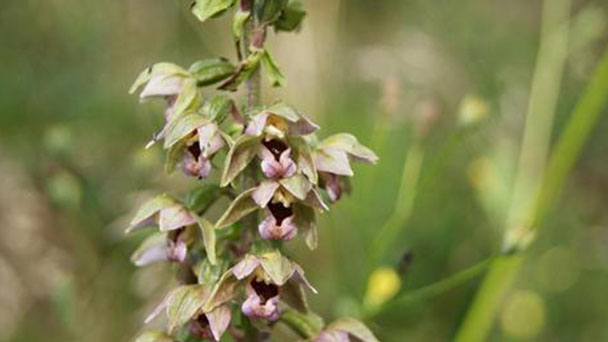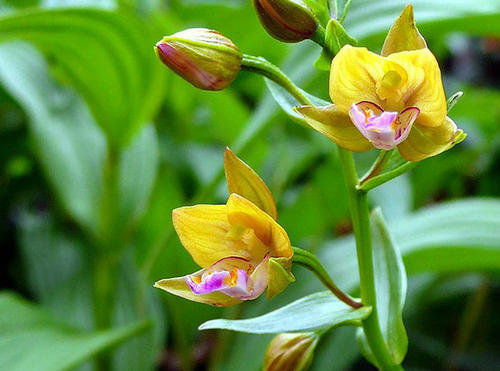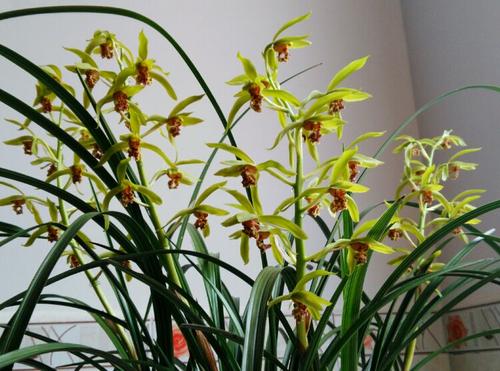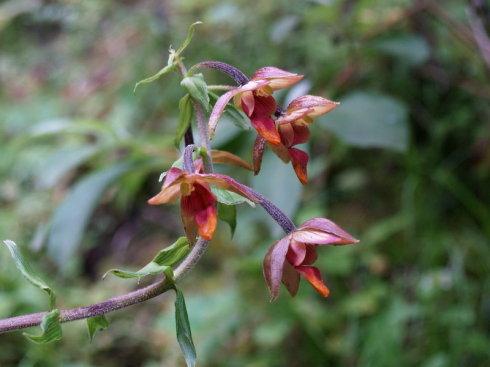Broad-leaved helleborine (Epipactis helleborine) profile
Written by Maggie
Mar 22 2021

Broad-leaved Helleborine (Epipactis helleborine) is an orchid plant, a ground acoustic herb. Broad-leaved helleborine is the authentic summer loh of Dianthus. It blooms in summer with about 10 flowers per stalk. The flowers are dark green, the petals are narrow and long and soft, and the stems are green and purple. The lip is green, the lip dish rises velvet, there is a horizontal stripe purple spot on. Leaves from U groove, veins fine and bright. Leaf tips often become scorched, said the fire tip. This product orchid's excellent point is: the summer fragrance alone, strong and long-lasting fragrance.
Broad-leaved helleborine picture

Morphological characteristics of broad-leaved helleborine
Rhizome
The height of broad-leaved helleborine is 20 ~ 70 cm; Rhizome is stout and short. Stem is pubescent distally, glabrous proximally, with 2 to 3 scaly sheaths.
Leaf
Broad-leaved helleborine has 7 leaves, alternate; Leaf blade is ovoid, ovate to elliptic-lanceolate, rarely lanceolate, 3 -- 13 cm long, 1 -- 6 cm wide, apex usually acuminate to long acuminate; The upward leaf Narrows gradually to become lanceolate or linear-lanceolate.
Flowers
Racemes of Broad-leaved helleborine are 10 -- 30 cm long, usually with 3 -- 40 flowers; Bracts are leaflike, linear-lanceolate, proximally 3 times or longer than flowers 2, tapered upward; Pedicels and ovaries are 1 -- 1.5 cm long, with yellowish-brown tomentose; Flowers are green or lavender, pendulous, smaller; Middle sepals are ovate-lanceolate, less elliptic, navicular, 8 -- 13 mm long, 4 -- 5 mm wide, apex acuminate; Lateral sepals are oblique-ovate-lanceolate, 9 -- 13 mm long, ca. 4 mm wide, apex acuminate; Petals are elliptic, 6 -- 8 mm long, 3 -- 4 mm wide, apex acute or obtuse; Lower sepal of Broad-leaved helleborine is 6 -- 8 mm long, conspicuously constricted at middle; Lower lip is sacculate, 3 -- 4 mm long; Upper lip is nearly triangular or nearly oblate, ca. 3 mm long, ca. 3 ~ 4 mm wide, apex acute, with a semicircular fold of about 1 mm long on each side of the near base, proximal apex sometimes slightly keel-like veins; Stamens ca. are 2 -- 5 mm (not including anthers). Capsule is obovate elliptic, ca. 1 cm long, with very sparsely pubescent hairs.
Ecological habits of broad-leaved helleborine
Broad-leaved helleborine is grown under forests, thickets or along ditches and roadsides at an altitude of 250 ~ 3600 m.
Cultivation of broad-leaved helleborine
Because broad-leaved helleborine has many and long roots, it should be planted in a pot with a diameter of 20cm-30cm. The substrate is loose, and acidic soil is needed. The humidity should not be too large.
Varietal taxonomy of broad-leaved helleborine
Broad-leaved Helleborine is an orchid species of the Xia Hui family. Hui is a kind of orchid, usually in the summer bloom, and a culm of eight or nine flowers more than ten flowers, the aroma is strong and light. Broad-leaved helleborine is the authentic summer loh of Dianthus. It blooms in summer with about 10 flowers per stalk. The flowers are dark green, the petals are narrow and long and soft, and the stems are green and purple. The lip is green, the lip dish rises velvet, there is horizontal stripe purple spot on.Leaves from U groove, veins fine and bright.Leaf tip often become scorched, said the fire tip.This product orchid excellent point is: the summer fragrance alone, strong and long-lasting fragrance.
Broad-leaved helleborine, as it is called locally, is a variety of the large family of descending jianlan. Individual broad-leaved helleborine can be found everywhere in the high mountains of eastern Fujian Province. It grows in areas of smooth grass and rock crevasses of fully lit mountains between 400m and 500m above sea level. Broad-leaved helleborine is drought tolerant and stress resistant. The leaf posture is peculiar, has a different grid, the plant height is 20cm-70cm; Leaves 0.9 cm-2cm;The number of leaves is 3-5; Leaf loss is more pure.
There are two varieties: one of which is hard and erect, the other of which is curved and weak, and the teeth of which are not obvious.
Leaves are erect, "u-shaped" cross section, "one-shaped" weak, pale green and dull, both colors. Pseudobulbs are elliptic, roots more stout and long. It was born in a harsh environment. Due to the destruction of natural climatic conditions, the seedling growth rate of broad-leaved helleborine was almost no 1:1, and it belongs to the hard-to-grow variety orchid.

The distribution of broad-leaved helleborine
Broad-leaved helleborine is produced in Liaoning, Hebei, Shanxi, Shaanxi, Gansu, Qinghai, Xinjiang, Anhui, Hubei, Sichuan, Guizhou, Yunnan and Xizang provinces.
Broad-leaved Helleborine is produced in Gongshan, Fugong, Lushui, Tengchong, Langping, Weixi, Deqin, Zhongdian, Jingdong, Lijiang, Dali, Heqing, Eryuan, Kunming, Luquan, Yiliang, Songming, Zhaotong, etc.
Broad-leaved helleborine is mainly distributed abroad in Bhutan, Sikkim, Nepal, Afghanistan, Iran, North Africa, Russia, Europe, and North America (known as wild).The type specimens were collected from Europe.
The role of broad-leaved helleborine
Ornamental value
Broad-leaved Helleborine germinates in spring. The buds have a pure and strong tip with winter shoot shape and tight leaf wrap. The broad-leaved helleborine grows in thatched grass with erect plants and more leaves. The plants are tall and straight with sword-like leaves, and the leaves are straight and blue sky facing the wind and sun.
Rhizome medicinal
Broad-leaved helleborine for fall injuries, kidney deficiency, low back pain, snake bite.

Latest Updated
- Benefits of Bugleweed - 7 Science-backed Health Benefits
- Bugleweed Dangers & Side Effects - Is It Poisonous?
- How to Plant Evergreen Trees - What You Should Know
- When to Plant Evergreens - Grow Guide for Evergreen Trees
- 12 Wonderful Evergreen Shrubs for Your Garden
- 12 Popular Evergreen Plants with Pictures for Beginners
- When And How To Prune A Lilac Bush Like a Pro
- How to Grow & Care for Lilac Vine (Hardenbergia Violacea)
- Japanese Lilac Tree (Syringa Reticulata) Care & Propagation Guide
- Shumard Oak Pros and Cons - What to Know
Popular Articles
- Winter maintenance of Antirrhinum Majus
- How to Grow Terminalia Mantaly Tree
- How to Grow and Care for Crossostephium Chinense
- How to grow Antirrhinum Majus in spring
- Peristeria Elata (Dove Orchid) Profile: Info & Care Guide
- Underwatered Snake Plant (Sansevieria Trifasciata) - Signs And How To Fix
- How to Care for Brazilian Jasmine Plant (Mandevilla Sanderi)
- How to Grow & Care for Graptopetalum Purple Delight in Summer
- Rosa Chinensis (China Rose): Plant Growing & Care Tips
- How to Care for Baby Sun Rose (Aptenia Cordifolia)